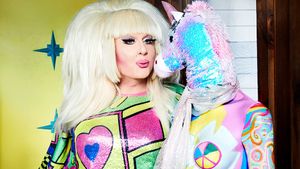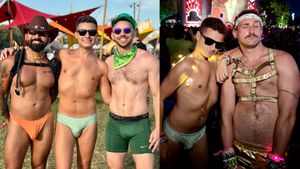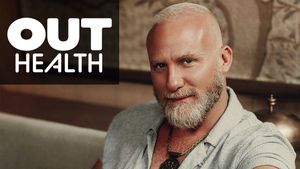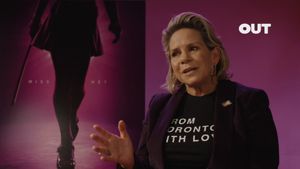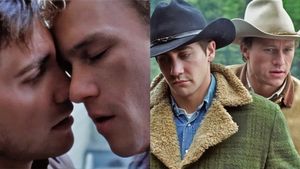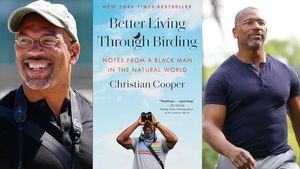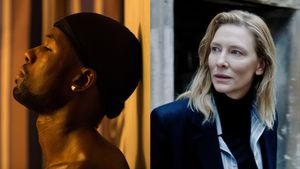Will Shepherd and R.J. Aguiar are a shining example of modern gay life. The 20-something fiances moved to Los Angeles just nine months ago from Tallahassee, Fla. Shepherd loves Pokemon and Chipotle. Aguiar is a film buff. They have a dog, Dobby, that they often walk in their neighborhood on the outskirts of West Hollywood.
An observer would think the two to be a quintessential happy gay couple. Yet this sunny Friday afternoon, walking to dinner in West Hollywood, Shepherd and Aguiar are bickering.
"Can you let me talk for once?" Shepherd says sharply as Aguiar tries to interject into a story his fiance is telling. It's a tense moment. Aguiar apologizes. Shepherd takes a deep breath. "I'm not a controlling bitch," he says. Then he continues his story.
It's the kind of snipe that most couples trade all the time. The two are obviously in love, after all. But unlike most couples, Shepherd and Aguiar have thousands of people watching, analyzing, and responding to every moment they choose to share.
Shepherd and Aguiar are vloggers -- video bloggers, members of the YouTube community who share a part of their lives on a regular basis. In their case, they film their everyday life -- every single day, 365 days a year. And that's just for their main channel. Shepherd also maintains his own gaming-focused channel, while Aguiar has a personal channel he describes as "a garbage dump for my brain." They also both maintain personal Twitter accounts, have a lively presence on a slew of other social media outlets, run a website for their brand, Not Adam and Steve, collaborate with other vloggers on their videos, and find time to work on other projects, like The OMEn Chronicles, a YouTube pilot.
For the YouTube-uninitiated, this may sound impossible. Even sharing so much of your life -- flaws and all -- can be intimidating. But for the vloggers who make their bones on the business of personality, it's expected.
In the past few years, YouTube has grown as a venue not just for silly viral videos but for vloggers looking to make their voices heard. These contributors -- "creators" in YouTube parlance -- aren't celebrities or actors. For the most part, they're ordinary people who excel at marketing themselves online. Creators' audiences vary in demographic, but with YouTube conventions like Playlist Live and VidCon expanding each year, their consumers are not only growing in number but becoming more and more passionate.
Within the greater YouTube community exists a particularly vibrant swath of LGBT vloggers. This group started with trans men and women chronicling their transition and young LGBT people needing a venue to come out, but now has expanded far beyond that. Some LGBT YouTubers are massively popular and talk exclusively about gay issues. Some are less popular and talk about a broad range of topics. Others fall somewhere in between.
With the fifth annual VidCon set to take place in Anaheim, Calif., in late June -- and with prominent media outlets like New York Magazine taking notice -- LGBT YouTubers are now, more than ever, having a major moment. But who are the key players? What makes someone want to commit all this time to sharing their life on YouTube? And what exactly does it take to make an impact when dozens of other vloggers look and sound just like you?
"You cannot talk about gay YouTube without talking about Tyler Oakley," Aguiar says of the 25-year-old vlogging powerhouse with bright purple hair. He's not wrong -- in many ways, Oakley is the mascot of gay YouTube. With 4.3 million subscribers, Oakley is far and away the most popular gay vlogger.
But when Oakley started filming videos of himself as a teenager in 2007, he never expected much to come of it. "People did it as a hobby, but only a very, very small group of people was doing it as a career," he recalls. "As time went on, I grew my audience and grew what I was doing on YouTube. It had never occurred to me that it could be a full-time career until it hit that tipping point."
Unlike Shepherd and Aguiar, who have a more demographically diverse audience, Oakley has a fan base composed primarily of young girls. As a self-described "professional fangirl," he finds his viewership fits his brand well. But Oakley insists that brand is a pure distillation of him.
"At the end of the day, it's me as a human," he says. "If it's me talking about my passions or me talking about my adventures or me talking about those things that bug me or my commentary about pop culture, it's 100 percent what you see is what you get. That's been my driving focus and mission from the start."
Though Oakley remains incredibly active on YouTube, he hasn't stayed there. Starting with a red carpet cohosting gig at the Trevor Project fundraiser TrevorLive a few years back, he's quickly made his way into more traditional media gigs, most recently cohosting the red carpet preshow for the MTV Movie Awards.
"That boy hustles harder than any person I've seen," Aguiar says of Oakley. "Insane work ethic. That's why he's kept it up for as long as he has: It works for him."
His quick ascent made New York Magazine take notice -- featuring him in a recent article on 20 up-and-coming Internet stars. But you don't get to the top of the gay YouTube mountain without picking up some haters. One Tumblr blog, Tyler Faukley, was created solely to point out Oakley's flaws. Another vlogger, Chescaleigh, has taken issue with Oakley's previous statements about diversity.
How does Oakley deal with haters? How do you think? He makes videos, of course.
Oakley repeatedly emphasizes that his YouTube career makes him happy -- and someone as successful as he is can't let criticism stop him from doing what he thinks is right.
"I think the measure of a lot of what you do in life is, are you doing things that make you happy, and are you doing things that do good in the world?" he says. "I think I've found a pretty good balance of both."
Halfway through dinner at West Hollywood's Kitchen 24, Shepherd whips out a portable camera and turns it on. "Hello, guys! So we are here with Kevin from The Advocate -- say hey! -- and we are in West Hollywood right now."
He trails off into a story about the waiter's indecisiveness in recommending a BLT or chicken club. There's a bit of whipping the camera back and forth as the couple talk, and then Shepherd turns the camera off.
Any moment in the day can be recorded and wind up in a vlog. It's quick and simple -- the way Shepherd likes it. Compare and contrast the couple's style with Oakley's: The latter primarily shoots videos directly in front of his camera at home. Think of it as two different schools of vlogging, though both forms require a great deal of work and have some similarities. First and foremost among those similarities is the need to collaborate with others.
A "collab," in YouTube lingo, is when one vlogger appears in another's video. Making time to pop into dozens of other YouTubers' worlds might seem impossible when there's so little room in vloggers' schedules. But as the guys explain, cross-promotion is key for growing audiences.
"People realize that, you know what, if we help each other, we can all achieve the dreams that we have," Oakley explains.
Aguiar is even more blunt about the necessity of collaboration. "Good luck trying to break in if you don't participate," he quips. "It behooves you much more to be part of the community."
It takes more than just playing nicely with others, though. Even for the most successful vloggers, YouTube's hefty 45 percent ad revenue take -- which Aguiar has critiqued previously -- means that if YouTube is your primary job, other forms of sponsorship are often a necessary survival strategy.
Of course, there's always the option of not making YouTube your primary job. Like John J. Salomone.
Salomone, better known by the online handle "DudeNeedAEaseOnUp," is a 20-something with a wide spectrum of interests, from video games to art. He's good-looking and has a cheery demeanor, starting all his videos with a wave and a sunny "Hey, everybody!" He's been on YouTube about as long as Oakley. He has all the ingredients you'd expect to see in a massively popular vlogger.
Yet Salomone's YouTube experience has been quite different. He sits at a more modest 76,000 subscribers and hasn't posted a video since March 10. His last video before that, the one above, was uploaded in December of last year. That video also explains why, after a channel relaunch last September aimed at producing weekly content, he stopped trying to make a career of YouTube.
"When I first started doing it, it was just for fun," Salomone says. "Then I got to a point where I was trying to make it a job. ... It could be a job for me, but there's a lot of things I'd have to do that I don't really like or am really OK with."
One of those unlikable things was YouTube's algorithm shift in 2012 to give preference to videos with better completion rates in search results -- in layman's terms, videos that viewers watched all the way through more often than not were billed higher on the site. In theory, this is a good thing; it rewards engagement over click bait. Furthermore, LGBT YouTubers who make videos about being LGBT or discussing LGBT issues also reap benefits, as viewers who watch for that particular subject can quickly access a number of videos about the subject.
But the shift also means that vloggers may feel compelled to focus on one subject instead of dealing with a variety. In other words, as Oakley puts it, "YouTubers may feel that they have to stick to a certain formula, because for whatever reason subscribers subscribe, they find a video that inspires them to subscribe, so a lot of people might think, Oh, I need to keep delivering that."
A brief glance at Salomone's channel shows he's bounced from reviews to personal vlogs to creating an immersive, interactive YouTube role-playing game. While some might enjoy the range of videos, in a medium where branding is king, variety is less marketable.
"I do feel like if I just made videos about being gay, I'd probably be a more successful YouTuber," Salomone says. "That's what people want to see. There's a huge audience on YouTube for that sort of thing."
But that wasn't what he wanted to do. "I don't have anything against the people who do that. I think it's great, and I think there are a lot of people -- a lot of gay YouTubers, their entire audience is young people who are not out of the closet yet or people who don't have anyone to talk to about these things," he concedes. "When it comes to that, there's a lot of merit to being a gay YouTuber. I feel like I'm a YouTuber who is gay, rather than a gay YouTuber."
To Shepherd and Aguiar, the point has some merit. "If you were to ask someone on the street about Gay YouTube, it's the flashy gays that you'd [hear about], the ones who talk about all the gay subjects," Shepherd says. "But if that's part of their brand, they're obviously doing a great job."
"But that doesn't have to be your brand," Aguiar adds. "Obviously, when you mention gay YouTubers, the ones who have being gay as part of their stamp are going to come to mind. But there are other creators out there who do plenty of other things and are still successful."
Salomone also acknowledges the gay YouTubers who focus on other subjects, while emphasizing that they still have to stick to their particular brand, even if that brand isn't LGBT-specific. He further takes issue with the rise in product placements and sponsorships in vloggers' videos.
"I like to be as transparent with subscribers as I can. If I'm selling a product, I can't pretend that I'm not," Salomone explains. "I feel like I can't lie to these people."
Oakley is no stranger to brand partnerships -- he's worked with Pepsi, Naturebox, and Taco Bell. He even maintains a strangely flirtatious relationship with Taco Bell's Twitter account.
Shepherd, whose videos with Aguiar are occasionally sponsored, sees why some viewers object to such advertising. But he and Aguiar reject far more sponsorship deals than make it to air, he says. "But every once in a while, there's a cool deal that will come through that actually has something to do with our lives," Shepherd says. "And they're offering a really good deal for our audience."
"That's our big thing. We try to be very selective about the brands -- we don't want to incorporate a brand into our video unless there's something they can give to our audience," Aguiar says, adding that despite haters, their core audience understands the need for occasional sponsorship. "You're always gonna have people who bitch, because people on the Internet love to bitch. They write their snide bullshit from a corner, because that's what the angry do nowadays."
While Salomone is content to return to what started him filming YouTube videos -- contributing the occasional video just for fun -- he can't see himself doing it as anything more than a part-time gig in the future.
"A lot of people think it's easy. But it's really freaking hard work," he says. "You're selling yourself. You are your money-maker. It's a lot of brand deals and collaborating and selling products. It's a lot of work. ... I don't know if I could do it."
Over dinner, Aguiar's bisexuality comes up. It's a subject that he's written about in the past -- including for The Advocate -- but he still feels the need to emphasize that he plays for "Team B."
"I just do feel the need to say that I do fall toward the middle, just because there's not a lot of people out there," he says. "If you have the stones to come out and say, 'Look, this is who I am,' that will, in turn, empower other people."
Diversity among LGBT YouTubers is, in some cases, fairly limited. Shepherd, Oakley, and Salomone are all white gay men (Aguiar is the son of Cuban immigrants), something that Shepherd says is fairly indicative of Gay YouTube as a whole.
"The LGBT community is gay white males on YouTube," he says, noting a common criticism of gay vloggers.
"There's a good amount of lesbians, but predominantly, it's gay men. We even get critiques about that," Aguiar adds, pointing out that there are some who stray from the mold. "Luckily, you have your Miles Jais."
Shepherd nods in agreement. "You have your Hartbeats."
Aguiar's face immediately breaks into a huge smile. "I love her!"
What's not to love about a bold, foulmouthed vlogger who films herself dancing in a watermelon bikini to make a point? Especially one who, as Michelle Hart (the real person behind Hartbeats) jokes, just wanted an excuse to dance in a watermelon bikini?
"When I finished the video, at the time I didn't think it would be popular at all. It took about two weeks to get attention," Hart says, noting that the video was a response to a question she heard far too regularly. "It's something I would generally get asked every day, either in person or the Internet."
Hart started watching YouTube videos in 2006 but didn't start contributing until 2009. It was a rough year for her, which found her searching for a community.
"I lost my friends, I lost my job, I had to come back and live in my mom's house, and I was bored," Hart says. "Once I saw there was a community on YouTube, I saw there were no big, black lesbians making videos."
As an opinionated person with viewpoints not commonly represented, including her body positivity and a perspective that even today isn't well-represented, Hart thought she could bring a new voice to LGBT YouTube.
"It's not fair at all," Hart says of the lack of diversity, adding that the community needs to "place focus on people who are underdogs."
"It's not even about skin color," she continues. "We have bisexuals and transgender people, two-mom families and two-dad families. Although, as a black woman, we could use some women or men of color on YouTube. Because we're often put into the shadows."
Even the range of ideas can grow stagnant on YouTube, Hart says. She considers those who watch the same videos and read the same things online to be part of one "unit," and notes that the members of said unit can get comfortable.
"Once they find the thing they like to do, they do the same thing over and over," she says, alluding to the formula Oakley described. "I have my own system, but I like to change it up."
One of the ways she's doing that is devoting the month of May to a character version of herself, Michelle. And Hart has no plans to stop challenging herself.
"I want to tour and meet people who have been watching my videos," she says. "I've been doing this for five years and I've only been able to go on a couple of trips. ... I would love for it to start off something small. I wanna go bold, go to colleges, speak on LGBT issues."
On second thought, Hart admits that high schools probably wouldn't let her speak. "I'm pretty raunchy," she says with a laugh.
{C}
As dinner wraps up, Aguiar recalls his and Shepherd's experience at Playlist Live in March. Unlike Oakley, who Aguiar says was constantly swarmed ("Bless him," Shepherd adds), they had considerably more tranquil time.
"We're not one of those people that gets mobbed," Aguiar says. "We get stopped periodically, we say hi, we hug them, we talk, we get to know them."
It's indicative of Shepherd and Aguiar's following -- at just under 150,000 subscribers, it's good, but it doesn't put them in the same class as a Tyler Oakley, or even a Hartbeat. But the couple insist the number isn't important.
"We don't like to measure our success in the number of subscribers we have," Aguiar says, noting that they've never lost followers throughout their time on YouTube. "We don't have the most subscribers; we have the best."
So if it's not in the search for millions of followers, what keeps Shepherd and Aguiar uploading videos daily? What makes chronicling over 800 days in less than three years worth it? What makes cultivating that core audience so important? Simply put, it's the same thing that got Shepherd interested in the first place: helping others.
"I think what makes gay YouTube different than regular YouTube is that we all are united behind that one purpose of finding those kids in those really isolated pockets of the world and telling them that they're not alone," Shepherd says.
Oakley agrees. "Maybe there's a gay kid in the middle of America that might feel like they're alone in the middle of coming out, and they may find my video," he speculates. "And hopefully, that's the reason that they find me. Because I want them to know they're not alone in the world, that they have a person they can connect to on whatever level."
For those needing role models, there's a vast range of resources -- after all, LGBT YouTube is larger than ever. But as it grows, Salomone says, the community will change. "That's the thing about YouTube ... the things that people are interested in watching change constantly," he explains. "You either have to keep up with it or fall behind. I've seen it happen over and over. The people who are popular now are going to be challenged."
Though it may be unbelievable to think of gay YouTube without Tyler Oakley -- a place where he's happy for the moment and "a firm believer of never wanting to leave something that makes me happy" -- one day, he will move on from the smallest screen. But, he emphasizes, he'll be taking the people who were with him from the start.
"Even though I have those other aspirations, I always want to incorporate my people," he says. "Because that's the reason why I'm able to do the things that I can do."
Likewise, Aguiar and Shepherd will find new ways to continue to serve out their mission. "I'm on YouTube to portray what gay life really is," Shepherd says. "Our goal when we got on YouTube was not to be a huge YouTube channel. It was to provide a resource for people who might need it."
Aguiar agrees: "That's what keeps us going."





